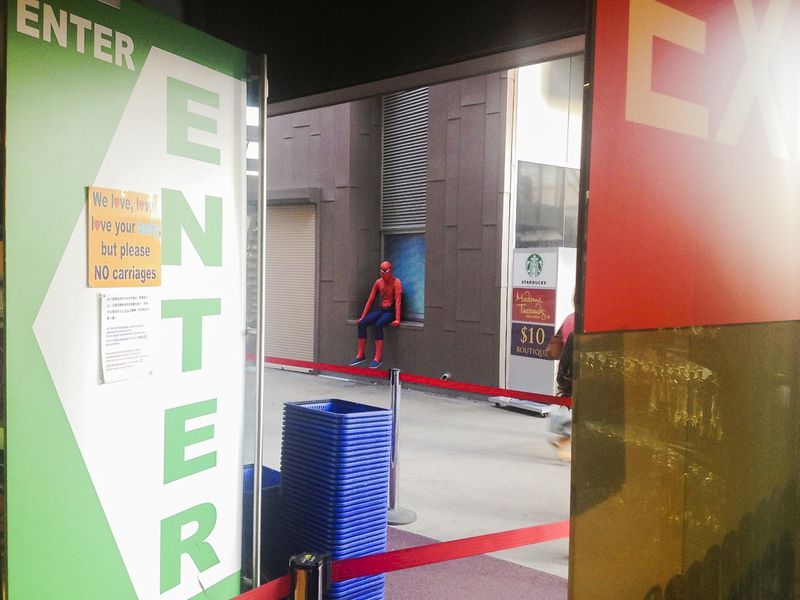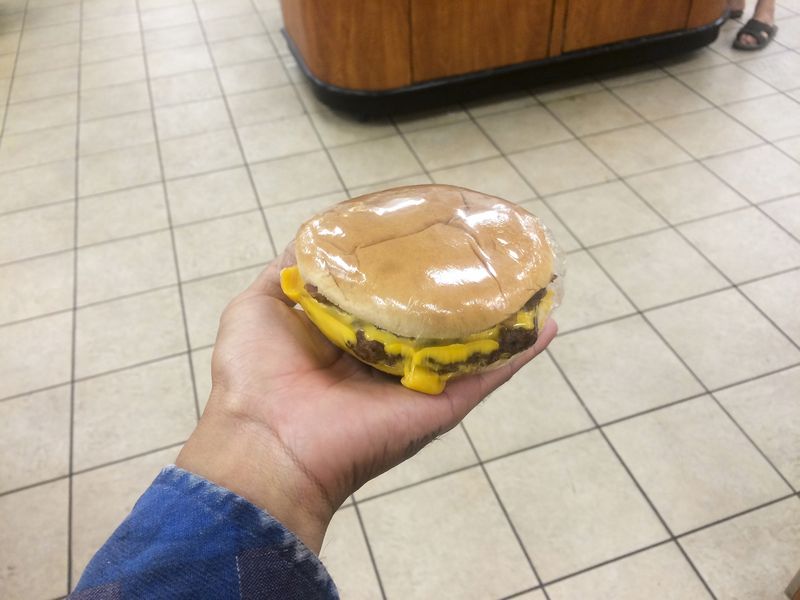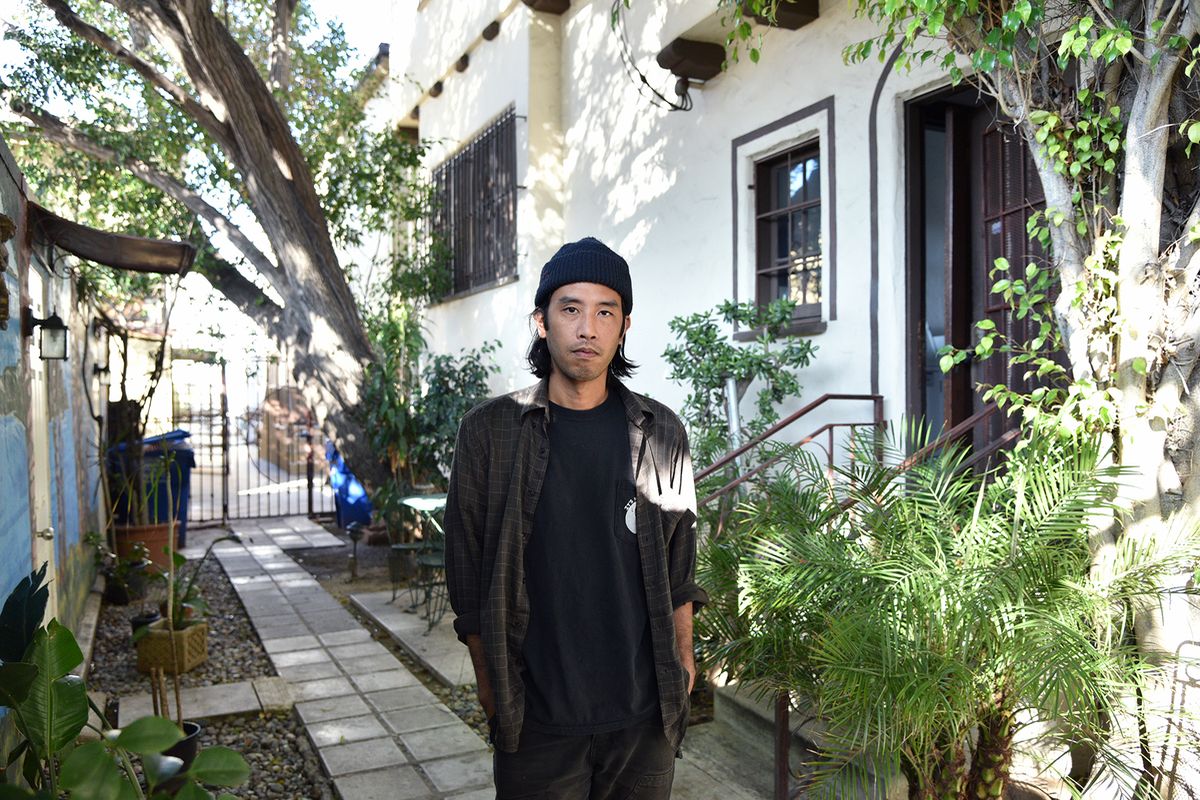[ad_1]
It was 2009 when California-based photographer and legendary pro-skateboarder Jerry Hsu first began his Tumblr blog. Titled NAZI GOLD, it was a curated “feed” comprised of cell phone photos in addition to his work with traditional photography and film practices. This blog, as well as the other one he curated titled Table for One, showcased his unique razor-sharp wit and fascination with life’s absurdities through unplanned snapshots of friends and strangers, skateboarding, roadside curiosities, juxtapositions and anything else that he deemed worth sharing.
These mobile snapshots are now compiled in his second book released by Anthology Editions, titled The Beautiful Flower Is the World. Referencing its genesis of an online blog, the book compiles the best of Hsu’s work throughout the years into an unerringly creative and endlessly clever chronicle of high and low America, raw and unfiltered. From dogs chilling out of the passenger side of a car to a giant cactus riddled with bullet holes, Hsu’s images are imbued with irony and razor-sharp humor.
The publication features matte black gilding on the outside page edges and metallic gold silk screening on the cover. The first edition also features an undisclosed number of signed photo prints will be placed inside a select number of books sold exclusively on the publisher’s website. The book will be accompanied by Launch events and exhibitions planned for the US and abroad, starting in Los Angeles.
We had a chat with Jerry Hsu about the initial idea behind his blog, the recently released publication, the common thread which runs through his work, the power of images, and much more.

Chronicling Life’s Unintentional Absurdities
Widewalls: Founded in 2009, your blog Nazi Gold Tumblr was running for almost ten years. What was the initial idea behind it and how did it evolve over time?
Jerry Hsu: So in 2007, I got a smartphone with the capability to take photos, on it I was just archiving them. I had originally been archiving photos in my phone for a couple of years and I just discovered Tumblr and showed a Tumblr I had created to my friend. It was a very garden variety Tumblr, the sort where you just kind of collect photos that you like, kind of a curation of things you like. I showed it to my friend and he didn’t like it so he said “why don’t you just make one with those phone photos you’ve been collecting”, so that’s really where it started. The initial idea was just a place, sort of a diaristic place where I was sharing my daily activities – that’s really where it started.
Widewalls: This blog served as a chronicle of life’s unintentional absurdities. What would be the common thread in these moments you found worth capturing?
JH: The common thread would be irony, but not all of them have any sense of irony at all. Some of them are very sincere but the intended result is the opposite of what happened.
That’s kind of why I was drawn to these particular moments. Something like a sign saying the opposite of what it intended to always made me love it.

The Beautiful Flower Is The World
Widewalls: Your photographs are all captured by a cellphone. Could you tell us something about the choice of this medium and how it influenced your practice?
JH: I originally started using the phone as a note-taking device, it was just something I wanted to save for later. I just need this low-resolution note of something and the phone was really perfect for that and it just sort of evolved into these sort of moments. I didn’t want to make a photograph of it but I wanted to save it but it ended up being a body of work. The phone just seemed so appropriate because the moments were so small and the phone was such a low resolution so I felt like it just worked together. How small the moments are, adds to the impact of what is happening – they’re almost invisible moments. So using the phone was appropriate because it’s so immediate.
Widewalls: Your second book will be released in May under the title “The Beautiful Flower Is The World”. How did you decide to turn a curated feed of cellphone images into printed matter?
JH: Well, one theme of these photographs is that their purpose is to be sent wirelessly/ digitally, and when you do that they degrade and every time you take something off the internet and send it to someone then they send it.
There’s a degradation that happens over time. I just wanted to experiment with that and then sort of, like making it a book just seemed that I would kind of stop that degradation. It would just finally end in a book where it could be and just exist in that way and stop living digitally and sort of gives it a weird life that way. It had such a frenetic life being shared and being put online over and over and over again so I just wanted to kind of stop it and kind of immortalize the images so it’s kind of why I wanted to make the book.
Widewalls: How do you think the meaning and power of an image has changed in an era of smartphones and social media?
JH: In one way, there is a cynical answer in this that so many images are being produced and shared that it takes away from all of them. But at the same time, in an era of social media, it can also elevate a photo to extreme importance the way a photo can be shared. It’s kind of like in the Vietnam era when once Americans started seeing what was happening, like really seeing what was happening, it changed the course of our political discourse. So it the same way, social media can do that, like with the image of a dead child on a beach in Turkey.
Photography is more powerful than ever I feel – that’s a positive way to look at it, but as far as image making, its harmful to me in that I’m so overwhelmed that sometimes it difficult to even get started. But I also feel like it’s very inspiring, there’s so much reference for me to go through and experience and enjoy and be inspired by.
I try to focus on what’s good about it, because if I think about what I don’t like or what’s annoying, I don’t end up making anything so I just try to think about how it helps me.

Skateboarding and Photography
Widewalls: You have been a central figure in the LA skate scene of the last 10 years. How did the skateboarding influence your photography?
JH: I feel like skateboarding and photography, especially the kind that I do are very complimentary because both skateboarding and my photography are kind of an interpretation of my environment. As a skateboarder, I’m constantly scanning my environment, I just want to see if there’s anything to skate, if there’s anything I can do with this object with these objects or whatever.
Photography is exactly the same way where I’m just scanning my environment to see if there’s anything useful or interesting to me so in that way I feel like they’re completely the same thing. I was a skateboarder first so maybe that’s informed the way my vision or the way I see things. They are totally complementary.
Widewalls: What’s next for you?
JH: I just want to keep doing photography projects and making books, I recently found all these high 8 tapes from when I was about 12 and 13 growing up skateboarding and I digitized them. I’ve been going through them and I feel like there is something there. It’s cool because it’s mixed – there’s family home footage mixed in with it too that my mom filmed, so it’s kind of cool. They’re immigrants from Taiwan, they moved to America for college, so it’s interesting to see their American dream happening.
Then I’m having my American dream too, at the same time sort of pursuing my dreams as a skateboarder and it’s all being documented. I’m also rejecting them and breaking away from them at the same time, so I feel like that project could be something, it could be nothing but that’s something I’m excited to work on.
Featured image: Jerry Hsu. Photo credit: Ray Potes
[ad_2]
Source link

